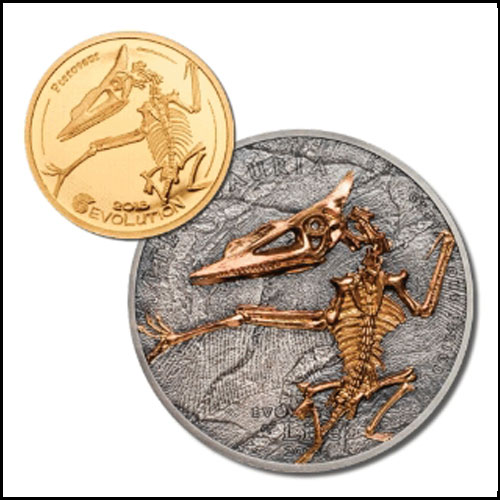Fossils of a Pterosaur Named Noripterus Parvus on New Mongolian Coins
2018-10-24 Wed
The fossils of a pterosaur named Noripterus Parvus was found in Tsagaantsav Svita, Mongolia. CIT issued a coin for Mongolian National Bank featuring these fossils on its reverse. Other inscriptions on the reverse include PTEROSAURIA, CRETACEOUS PERIOD and EVOLUTION of Life 2018. A rose-gilded skeleton of the pterosaur emerges out from a rugged background of the coin’s back, to recreate the archaeological site. The obverse features the coat of arms of the Mongolian National Bank, 500 togrog in Cyrillic and MONGOLIA 1 oz .999 SILVER in Latin. The design for the gold coin remains the same except for an ammonite in front of the word Evolution. It is the fourth coin to be issued in the “Evolution of Life” series. The three earlier coins in the series are dedicated to Ammonite, Trilobite, and Ichthyosaur.The coin is struck in such a way that the reverse looks like a stone. The high relief is achieved using smartminting technology and the rose gilding on pterosaur’s fine skeleton is added skilfully. The 500 Togrog coin is struck on 1 oz of 0.999 Fine Silver with an Antique Finish and has a mintage limit of 999 pieces. The 1,000 Togrog Proof coin is struck on 0.5 grams of 0.9999 Fine Gold and has a mintage limit of 15,000 pieces. Both these versions were struck at B.H. Mayer’s Kunstprageanstalt, Munich.
Pterosaurs had large wing membranes and were the first vertebrates which could fly. This geological formation dates back to the early Cretaceous period, about 145 million years ago. Research suggests that Noripterus Parvus had a wingspan of 4 meters and ate shellfish using its strong jaws.
Image Courtesy: Coin Invest Trust
Latest News
-
Mahatma
2024-04-25 ThuIndia Post issued a commemorative postage stamp on #LalaHansraj, also known as Mahatma Hansraj for�...
-
Berar Mint of Muhammad Akbar
2024-04-25 ThuBerar was a kingdom located in the Deccan region, with Elichpur as its capital. It was one of the Su...
-
Janma Kalnayak of Bhagwan Mahavir
2024-04-24 WedOn 21st April 2024 which was the 2550th Janma Kalnyanak of Bhagwan Mahavir Swami, PM Modi unveile...
-
Gold Pagoda of Vijaynagar Empire King Deva Raya I
2024-04-10 WedKing Deva Raya I of the Vijayanagara Empire was a patron of Kannada literature and architecture. He ...
-
Silver Denarius of Septimus Severus
2024-04-05 FriLucius Septimius Severus served as the Roman emperor from 193 to 211 AD. Severus sat on the throne o...

